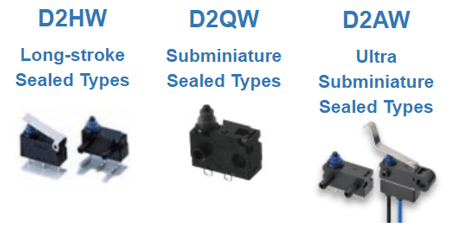What are basic switches with a long stroke?
ID: FAQE20006E
update:
Answer
The stroke of a basic switch is basically proportional to the size of the switch. Therefore, the longer (larger) the stroke of the basic switch you select, the larger the switch becomes. However, the lever actuator makes the stroke longer (larger) even if the switch is small. The longer the lever actuator is, the longer (larger) the stroke becomes while the smaller the OF (operating force) and RF (release force) become. As a result, when the OF is reduced, you need to select a lever actuator.
Explanation
The V-type and S-type switches are pushbutton types with almost the same stroke, and the lever actuator increases the stroke.
D2HW, D2QW, and D2AW have a longer stroke compared to the size of the switch, making it easier to set.
Please note that D2HW, D2QW, and D2AW models have achieved a small long stroke with their unique structure.

Full stroke of switch:
- V size (common to pushbutton/lever): Stroke = PT+OT
- S size/J size (pushbutton): Stroke = PT + OT
- S size/J size (lever): Stroke = (FP-OP) + OT

For more information, see "Switch Basics".
Quick tips
The larger the PT, the more allowance (margin of variation) is attained in the setting (operating point).
A small long-stroke model (D2HW, D2QW, D2AW) is recommended when the installation space is small.
Please note that they have no high-capacity switching. Please check the electrical load.
For more information, see Product pages.
| Product category | Switches Basic Switches |
|---|---|
| Classification | Selection, Characteristics |
| Related keywords |
|